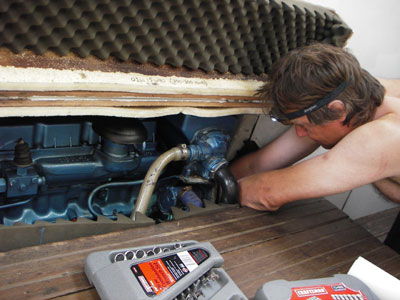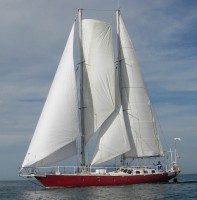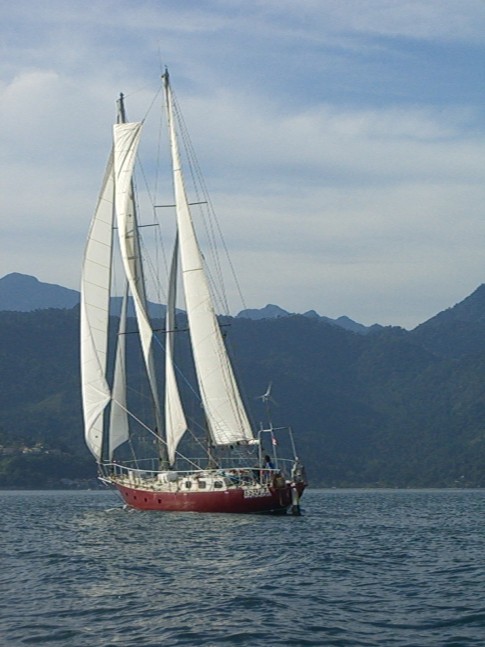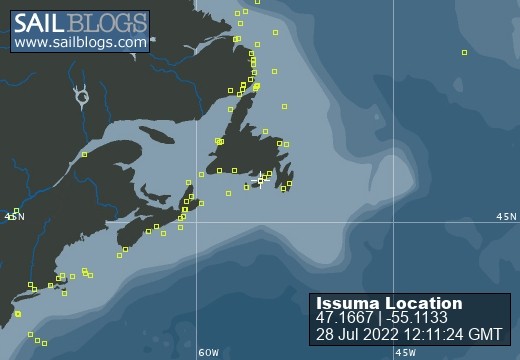
Issuma
28 July 2022
28 July 2022
08 May 2022
18 April 2022
07 April 2022
04 March 2022
17 February 2022 | Little Bay, Marystown, Newfoundland, Canada
16 February 2022
09 February 2022
06 February 2022 | Little Bay, Marystown, Newfoundland, Canada
05 February 2022 | Little Bay, Marystown, Newfoundland, Canada
01 February 2022 | Little Bay, Marystown, Newfoundland, Canada
30 January 2022 | Little Bay, Marystown, Newfoundland, Canada
25 January 2022 | Little Bay, Marystown, Newfoundland, Canada
24 January 2022 | Duricle Cove
17 January 2022
11 September 2021 | Little Bay, Marystown, Newfoundland, Canada
27 August 2021 | Grey River
26 August 2021 | Grand Bruit
26 July 2021 | Isle Valen
From Punta de Antiquera, Tenerife to Las Palmas, Part II
05 July 2008 | Canary Islands
Brittany

Sailing the ocean is more than a little different from sailing Long Island Sound. The seas are higher, the breeze is stiffer, and Issuma is a lot of boat to sail (21 tons of steel schooner, 15.3 meters/52 feet long!). She's a very fast boat, which is fantastic, but because she's a big, stiff boat, all of her hardware, fittings, and running rigging are also big and stiff (the spring line is the size of an adult Amazonian Python). Lots of tugs-of-war, muttered expletives and switching from short to long-fingered gloves attest to this. In spite of the struggles, learning how to sail Issuma is a lot of fun. Richard taught me how to use the wind vane, read the fishfinder for depth, and how to use the roller furlers for the voile d'etai and trinquette. I'd have to attend body-building school for a year before I could ever raise the mainsail, but Richard can take care of that.
Also, while ocean sailing is fun and exciting, it is not exactly relaxing. In fact, it's mentally exhausting as you must remain ever-alert and constantly checking your heading, making adjustments with the windvane, checking speed, and constantly looking out for boat traffic. We crossed a TSS (Traffic Separation Scheme) between Tenerife and Gran Canaria, and had to look out and give way for any commercial vessels moving in either lane. At one point it appeared that an enormous, 4-domed liquified gas tanker was headed straight for our starboard side. I was feeling un poco concerned. Fortunately, though, we began to see more of the tanker's starboard and it passed peacefully behind us....liquid explosives and all. It was a tender moment.
We were concerned about how we would enter a new, unknown harbor and anchor safely without our engine. When I stood watch, Richard investigated the engine's malfunction, and discovered that one of the engine cooling pipes had developed holes in a very difficult-to-reach spot. This had caused the engine to lose its coolant and overheat. He assiduously worked on temporarily repairing the engine with epoxy, and because of his efforts, we had limited use of the engine for our entry into Las Palmas harbor. Thank Poseidon, because attempting to enter this busy harbor--blinded by the setting sun and with a stream of giant freighters barreling out of it--was like New York Harbor on steroids. Given our very limited understanding of Spanish further hampered by static, we were unable to determine from the radio what the freighters' plans were. We were still under sail as a giant freighter, Catania, played mind games as it waited with us to enter the harbor. It would turn, so we would tack, then it would turn again, and we would tack again. Finally, we were only a few hundred meters from the entrance, and doing 5 knots, when another freighter emerged from the harbor's mouth. In spite of our bittersweet proximity to the entrance, we conceded in the face of this behemoth, tacked over and away from the entrance. At this point, Catania had moved forward and entered the harbor, and we followed in Catania's wake, figuring that no other freighter would be near the narrow entrance at the same time.
Gleefully entering the harbor, we were somewhat dismayed to see yet another monster freighter, Gruppo Boludo, come charging around the corner. At this point, though, we were able to stay out of the way of Gruppo Boludo, and safely sail in. Thankfully, Gruppo Boludo was the last of the departing giants, and we safely continued forward into the harbor. Phew! Turning on the engine and dropping sail, we found Marina de Las Palmas, and successfully dropped anchor north of the marina. The flat bay and light breeze is a pleasant contrast to the chop and gusty winds of Punta Antiquera of Tenerife the night before. Now it's time to hit the ferreterias and more fully repair the engine. Ahhhh, sailing. :)
Also, while ocean sailing is fun and exciting, it is not exactly relaxing. In fact, it's mentally exhausting as you must remain ever-alert and constantly checking your heading, making adjustments with the windvane, checking speed, and constantly looking out for boat traffic. We crossed a TSS (Traffic Separation Scheme) between Tenerife and Gran Canaria, and had to look out and give way for any commercial vessels moving in either lane. At one point it appeared that an enormous, 4-domed liquified gas tanker was headed straight for our starboard side. I was feeling un poco concerned. Fortunately, though, we began to see more of the tanker's starboard and it passed peacefully behind us....liquid explosives and all. It was a tender moment.
We were concerned about how we would enter a new, unknown harbor and anchor safely without our engine. When I stood watch, Richard investigated the engine's malfunction, and discovered that one of the engine cooling pipes had developed holes in a very difficult-to-reach spot. This had caused the engine to lose its coolant and overheat. He assiduously worked on temporarily repairing the engine with epoxy, and because of his efforts, we had limited use of the engine for our entry into Las Palmas harbor. Thank Poseidon, because attempting to enter this busy harbor--blinded by the setting sun and with a stream of giant freighters barreling out of it--was like New York Harbor on steroids. Given our very limited understanding of Spanish further hampered by static, we were unable to determine from the radio what the freighters' plans were. We were still under sail as a giant freighter, Catania, played mind games as it waited with us to enter the harbor. It would turn, so we would tack, then it would turn again, and we would tack again. Finally, we were only a few hundred meters from the entrance, and doing 5 knots, when another freighter emerged from the harbor's mouth. In spite of our bittersweet proximity to the entrance, we conceded in the face of this behemoth, tacked over and away from the entrance. At this point, Catania had moved forward and entered the harbor, and we followed in Catania's wake, figuring that no other freighter would be near the narrow entrance at the same time.
Gleefully entering the harbor, we were somewhat dismayed to see yet another monster freighter, Gruppo Boludo, come charging around the corner. At this point, though, we were able to stay out of the way of Gruppo Boludo, and safely sail in. Thankfully, Gruppo Boludo was the last of the departing giants, and we safely continued forward into the harbor. Phew! Turning on the engine and dropping sail, we found Marina de Las Palmas, and successfully dropped anchor north of the marina. The flat bay and light breeze is a pleasant contrast to the chop and gusty winds of Punta Antiquera of Tenerife the night before. Now it's time to hit the ferreterias and more fully repair the engine. Ahhhh, sailing. :)
Comments
| Vessel Name: | Issuma |
| Vessel Make/Model: | Damien II, 15m/50' steel staysail schooner with lifting keel |
| Extra: | Designed for Antarctica. Built in France by META in 1981. Draft 1.3m/4.5' with keel up, 3.2m/10.5' with keel down. More details at http://www.issuma.com/rhudson/issumaboat/IssumaDetails.htm |
| Home Page: | http://www.issuma.com/rhudson/ |
| Social: |



